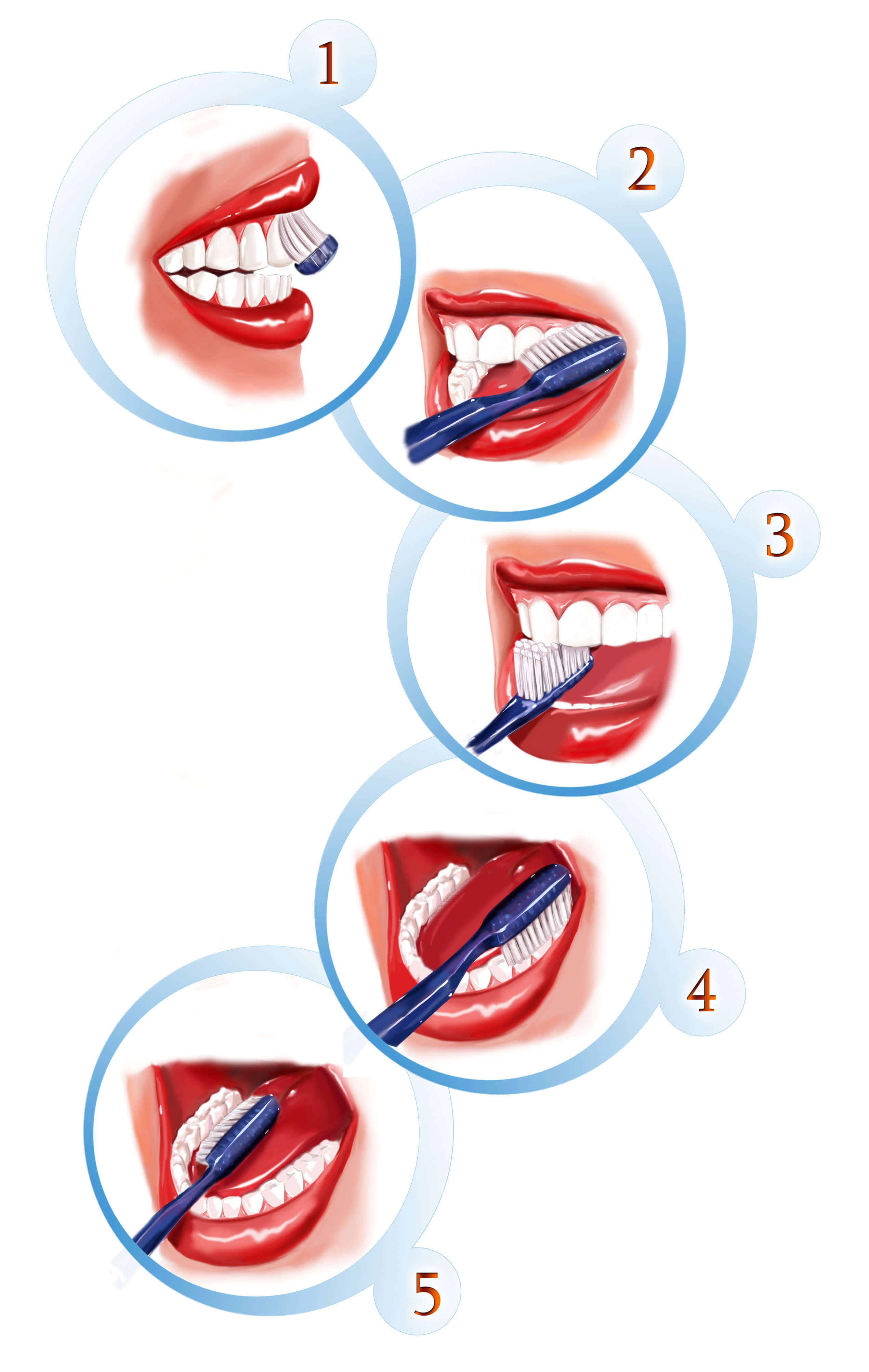Brush your teeth twice a day for two minutes each time using gentle, circular motions to clean all surfaces. Maintaining good oral hygiene starts with proper brushing techniques and habits.
By brushing your teeth twice a day for two minutes each time, you can effectively remove plaque and prevent various dental problems. It’s important to use a soft-bristle toothbrush and fluoride toothpaste to ensure a gentle clean. Make sure to reach all surfaces of your teeth, including the outer, inner, and chewing surfaces, using small circular motions.
Don’t forget to also brush your tongue to remove bacteria and freshen your breath. By following these simple steps, you can maintain a healthy and beautiful smile.

Credit: www.fraundorferdentistry.com
Importance Of Brushing Your Teeth
Brushing your teeth is an essential part of maintaining good oral hygiene. It not only keeps your teeth clean and your breath fresh, but it also plays a crucial role in preventing dental problems. By brushing your teeth regularly, you can prevent tooth decay and gum disease, ensuring a healthy and confident smile.
Preventing Tooth Decay
One of the primary reasons why it is important to brush your teeth is to prevent tooth decay. Tooth decay occurs when plaque, a sticky film of bacteria, builds up on your teeth, producing acids that erode the enamel. Over time, this can lead to cavities or dental caries, which can cause pain, sensitivity, and even tooth loss. By brushing your teeth at least twice a day, you can remove plaque and prevent the formation of cavities.
Preventing Gum Disease
Another crucial reason to brush your teeth is to prevent gum disease. Gum disease, also known as periodontal disease, is an infection of the tissues that surround and support your teeth. It starts with the buildup of plaque along the gumline, which can lead to inflammation and gum recession. If left untreated, gum disease can progress, causing gum damage, tooth loss, and even systemic health problems. By brushing your teeth properly, you can remove plaque and prevent gum disease, ensuring the health of your gums.
To effectively prevent tooth decay and gum disease, it is important to establish a proper brushing routine. Here are some tips to help you brush your teeth effectively:
- Use a soft-bristled toothbrush and fluoride toothpaste.
- Hold the toothbrush at a 45-degree angle to your gums.
- Gently brush all surfaces of your teeth, using circular motions.
- Pay special attention to the gumline, where plaque tends to accumulate.
- Brush your tongue to remove bacteria and freshen your breath.
- Brush for at least two minutes, twice a day.
- Replace your toothbrush every three to four months.
- Visit your dentist regularly for professional cleanings and check-ups.
By following these simple yet crucial steps, you can maintain optimal oral health and enjoy the benefits of a healthy smile. So, make brushing your teeth a priority in your daily routine and keep your teeth and gums happy and healthy!
Choosing The Right Toothbrush And Toothpaste
When it comes to maintaining good oral hygiene, brushing your teeth regularly is an essential practice. However, the effectiveness of brushing depends on using the right toothbrush and toothpaste. In this section, we will focus on the importance of selecting the right toothbrush and toothpaste, and how these choices can contribute to maintaining optimal oral health.
Selecting The Right Toothbrush
Choosing the right toothbrush is crucial for proper oral care. Here are some key factors to consider:
- Bristle Softness: It is recommended to choose a toothbrush with soft bristles. Soft bristles effectively clean your teeth without causing any damage to your gums or enamel.
- Size and Shape: Toothbrushes come in various sizes and shapes. Ensure that the toothbrush you select can comfortably reach all areas of your mouth, including the back teeth.
- Handle Grip: Look for a toothbrush with a comfortable grip that allows you to hold it firmly while brushing.
- Replacement Frequency: It is important to replace your toothbrush every three to four months or when the bristles start to fray. Using a worn-out toothbrush can be less effective in cleaning your teeth.
Choosing The Right Toothpaste
While selecting the right toothbrush is important, equally crucial is choosing the right toothpaste. Here are some key factors to consider:
- Fluoride Content: Look for toothpastes that contain fluoride, as it helps strengthen your teeth and protect against dental cavities.
- Specific Dental Needs: Consider your specific dental needs when choosing a toothpaste. For example, if you have sensitive teeth or gums, opt for a toothpaste designed for sensitivity.
- ADA Approval: Ensure the toothpaste you choose has the American Dental Association (ADA) seal of approval. This seal guarantees that the toothpaste has undergone extensive testing for safety and effectiveness.
- Taste and Texture: Personal preference plays a role in toothpaste selection. Experiment with different flavors and textures to find a toothpaste that you enjoy using, as this can encourage regular and thorough brushing.
Proper Brushing Technique
Learn the proper brushing technique with these 6 simple guidelines to effectively clean your teeth. Follow these steps for optimal oral hygiene and maintain a healthy smile.
Brushing your teeth properly is essential for maintaining good oral health. By following the correct technique, you can effectively remove plaque and prevent cavities, gum disease, and bad breath. In this section, we will explore the step-by-step process of proper brushing. Let’s get started!
Step 1: Wetting The Toothbrush
Before applying toothpaste, wet your toothbrush under running water. This helps soften the bristles and ensures the toothpaste spreads easily on your teeth.
Step 2: Applying Toothpaste
Squeeze a pea-sized amount of toothpaste onto the bristles of your wet toothbrush. Opt for a fluoride toothpaste, as it strengthens the enamel and fights tooth decay. Brushing with too much toothpaste may lead to excessive foaming and can be harmful if swallowed.
Step 3: Brushing Your Teeth
Hold your toothbrush at a 45-degree angle to your gum line. Using short back-and-forth motions, gently brush the outer surfaces of your teeth. Be sure to cover all areas, including the chewing surfaces and the inner surfaces facing your tongue. Divide your mouth into quadrants and spend around 30 seconds on each.
Step 4: Brushing Your Tongue
Don’t forget to brush your tongue! Bacteria can accumulate on the surface, leading to bad breath. Using gentle strokes, brush your tongue from back to front. This helps remove bacteria and leaves your mouth feeling fresh.
Step 5: Rinsing And Cleaning The Toothbrush
After brushing, thoroughly rinse your mouth with water to remove any leftover toothpaste and debris. Rinse your toothbrush as well. It is crucial to keep your toothbrush clean and dry to prevent the growth of bacteria. Store it upright in a well-ventilated area to allow it to air-dry between uses.
By following these steps and practicing proper brushing technique, you can maintain a healthy and vibrant smile. Remember to brush at least twice a day for two minutes each time. Don’t forget to replace your toothbrush every three to four months or when the bristles become frayed. Take care of your oral health, and it will surely thank you!
Frequently Asked Questions On How To Brush Your Teeth
Why Is Brushing Your Teeth Important?
Brushing your teeth is crucial for maintaining good oral health. It helps remove plaque and bacteria that can cause tooth decay and gum disease. Regular brushing also helps prevent bad breath and keeps your teeth looking clean and bright.
How Often Should You Brush Your Teeth?
It is recommended to brush your teeth at least twice a day, once in the morning and once before bed. This helps remove plaque and bacteria that accumulate throughout the day and night.
What Type Of Toothbrush Is Best?
A soft-bristled toothbrush with a small head is generally recommended. It allows for better access to hard-to-reach areas and is gentle on the gums. Electric toothbrushes can also be effective, especially for individuals with limited dexterity.
How Long Should You Brush Your Teeth?
Ideally, you should brush your teeth for a full two minutes each time. This ensures that you thoroughly clean all surfaces of your teeth and gums. Using a timer or brushing along to a song can help you keep track of the time.
Conclusion
Remember, proper teeth brushing plays a vital role in maintaining good oral health. By following the correct technique and incorporating it into your daily routine, you can reap the benefits of a healthy and beautiful smile. So, make sure to invest time in brushing your teeth effectively, using the right toothbrush and toothpaste, and visiting your dentist regularly.
Start today and take control of your dental health for a better and brighter future. Keep smiling!

I am a dentist and also blog regularly. my target audience is America Europe & providing regular information for them.
